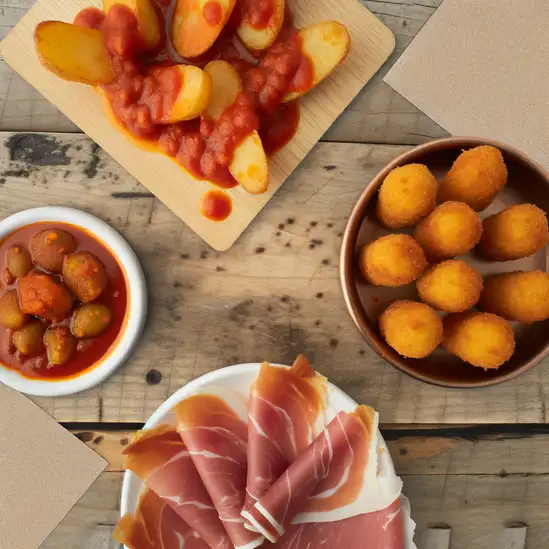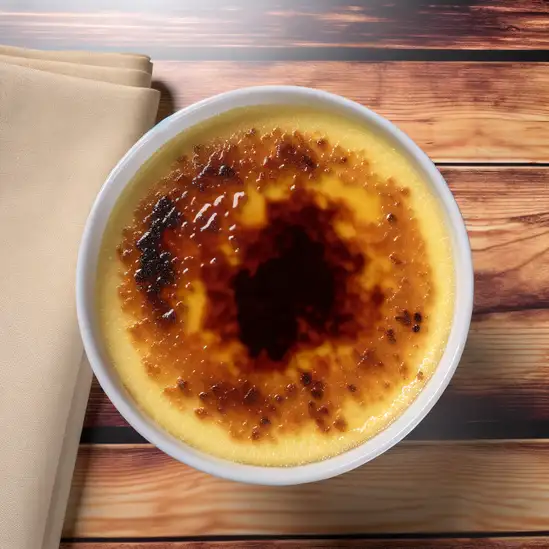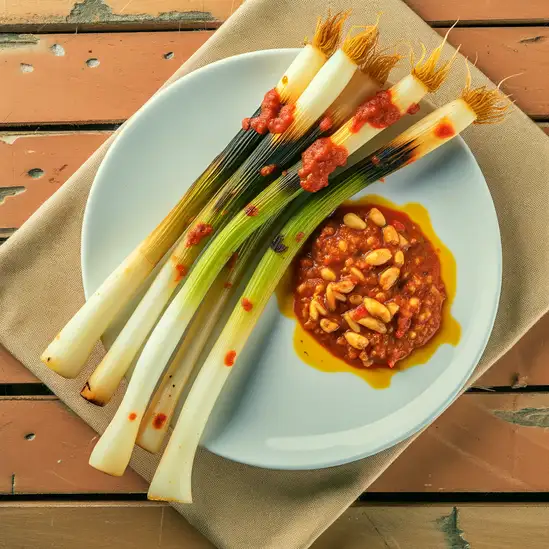


Barcelona feels like a vibrant mosaic where every corner pulses with life and color. The moment you step onto its sun-drenched streets,you’re wrapped in a warm Mediterranean embrace—salt in the air,the distant hum of waves mingling with lively chatter from bustling cafés. The city’s energy is contagious,a blend of old-world charm and modern creativity that invites you to slow down and savor each moment. Wandering through the narrow alleys of the Gothic Quarter,you’ll hear the soft clinking of glasses and the melodic strum of a street guitarist,while the scent of fresh-baked bread and roasting coffee drifts from cozy bakeries. Barcelona’s architecture is like a living art gallery—Gaudí’s whimsical buildings,with their undulating lines and vibrant mosaics,feel almost dreamlike against the bright blue sky. It’s a place where history and imagination dance together. Food here is a celebration in itself. Imagine biting into a perfectly crispy,golden croqueta or savoring the rich,smoky flavors of a traditional paella,all washed down with a glass of chilled cava. The city’s markets,like La Boqueria,burst with colors and aromas—ripe tomatoes,fresh seafood,and fragrant herbs—that make you want to taste everything. What makes Barcelona truly special is its spirit:a city that lives passionately,where locals and visitors alike gather to share stories,laughter,and the simple joy of being in a place that feels both timeless and alive. Trust me,once you’ve experienced it,you’ll carry a piece of Barcelona’s magic with you long after you leave.
The information on this page is currently being reviewed by Tripkliq and should be used as a guide only
Eng word: Hello
Eng pronunciation: OH-lah
Local language: Hola
Eng word: Goodbye
Eng pronunciation: ah-DYOS
Local language: Adiós
Eng word: Thank you
Eng pronunciation: GRAH-syahs
Local language: Gracias
Eng word: How much
Eng pronunciation: KWAN-toh KWEH-stah
Local language: ¿Cuánto cuesta?
Eng word: Toilet
Eng pronunciation: BAH-nyoh
Local language: Baño
Eng word: Help me
Eng pronunciation: ah-YOO-dah-meh
Local language: Ayúdame
Eng word: Yes
Eng pronunciation: SEE
Local language: Sí
Eng word: No
Eng pronunciation: NO
Local language: No
Eng word: Excuse me
Eng pronunciation: pehr-DOHN
Local language: Perdón
Barcelona was originally founded as a Roman city called Barcino in the late 1st century BC. Its strategic location on the Mediterranean Sea made it an important Roman colony.
During the medieval period, Barcelona emerged as a major commercial and maritime center in the Mediterranean, especially under the rule of the Crown of Aragon.
The Gothic Quarter is the center of the old city of Barcelona. Many of its buildings date back to medieval times, with some foundations built on Roman ruins.
Hosting the 1992 Summer Olympics brought international attention to Barcelona and prompted a major period of urban renewal and development for the city.
Famed architect Antoni Gaudí left an indelible mark on Barcelona with his unique approach to Catalan Modernisme. Iconic works include the Sagrada Família and Park Güell.
Las Ramblas is a bustling street in the heart of Barcelona, famous for its lively atmosphere, street performers, and markets, connecting Plaça de Catalunya with the Christopher Columbus Monument.
FC Barcelona, one of the world’s most prestigious football clubs, was founded in 1899. The club has become an emblem of Catalan culture and identity.
The Barcelona Pavilion, designed by Ludwig Mies van der Rohe for the 1929 International Exposition, is a landmark of modern architecture.
Built for the 1929 International Exposition, the Magic Fountain of Montjuïc is famous for its spectacular displays of color, light, motion, music, and water acrobatics.
In Barcelona, the most common Power Adaptor is Type C, Type F.



A traditional Spanish rice dish cooked with a variety of ingredients such as seafood, chicken, and vegetables, seasoned with saffron and other spices.

Small plates of appetizers or snacks that can include a variety of dishes like patatas bravas (fried potatoes with spicy tomato sauce), croquetas (fried breadcrumb-coated rolls), and jamón ibérico (cured ham).

A creamy dessert similar to crème brûlée, made with milk, sugar, egg yolks, and flavored with cinnamon and lemon zest, then caramelized on top.

Grilled spring onions served with a nut and red pepper-based sauce called Romesco, a popular Catalan dish typically enjoyed during the calçotada festival.
Valencia feels like a sun-drenched embrace the moment you step into its lively streets. There’s this effortless blend of old-world charm and modern energy that makes you want to slow down and soak it all in. Imagine wandering through narrow alleys where the scent of fresh oranges mingles with salty sea air,while the distant hum of lively chatter and clinking glasses spills out from cozy tapas bars. The city pulses with life,but it’s never overwhelming—more like a warm invitation to explore at your own pace.
What really sets Valencia apart is its vibrant culture and the way it celebrates food and community. You can’t visit without tasting authentic paella right where it was born,the saffron-infused rice bursting with fresh seafood or tender chicken,paired with a glass of chilled local wine. The Mercado Central is a feast for the senses,overflowing with colorful produce,fragrant spices,and the friendly banter of vendors who clearly love their craft.
Beyond the city’s historic heart,the futuristic City of Arts and Sciences offers a striking contrast—gleaming white structures that look like they belong in a sci-fi movie,surrounded by tranquil water reflecting the sky. And when you need a break,the Turia Gardens stretch out like a green ribbon,perfect for a bike ride or a lazy afternoon picnic. Valencia isn’t just a place to visit; it’s a place to feel alive,where every corner invites you to discover something new and deliciously unexpected.
Imagine stepping into Palma,and instantly feeling the gentle Mediterranean breeze wrap around you,carrying the scent of salty sea air mixed with freshly baked ensaimadas from a nearby bakery. This city pulses with a laid-back yet vibrant energy—where ancient stone streets meet sleek modern cafes,and the golden light of the sun casts a warm glow over the terracotta rooftops. Palma isn’t just a place to see; it’s a place to soak in,with its lively plazas where locals chat over cortados and the distant hum of guitar strings drifting from a tucked-away bar.
Wandering through the old town,you’ll find yourself mesmerized by the soaring Gothic cathedral,its intricate details catching the sunlight in a way that feels almost magical. Around every corner,there’s a story—whether it’s the colorful market stalls bursting with fresh produce and spices or the quiet courtyards where bougainvillea spills over ancient walls. The city’s character is a beautiful blend of tradition and modernity,where centuries-old architecture sits comfortably alongside trendy boutiques and art galleries.
And the food—oh,the food! Tapas here are an experience,from tender sobrassada to briny olives and perfectly grilled seafood,all paired with a glass of local wine that tastes like sunshine in a bottle. Palma invites you to slow down,savor each moment,and feel like you’re part of a living,breathing canvas painted with warmth,history,and a touch of Mediterranean magic.
If you ever find yourself wandering through the heart of Castilla-La Mancha,Sevilleja de la Jara is one of those places that quietly pulls you in with its unhurried rhythm and genuine warmth. The moment you step into its sun-dappled streets,there’s a comforting stillness,broken only by the soft chatter of locals and the occasional clink of glasses from a nearby terrace. It’s the kind of town where time seems to slow,inviting you to breathe in the scent of wild herbs carried on the breeze and the earthy aroma of freshly tilled fields surrounding the village.
The character of Sevilleja de la Jara is deeply tied to its landscape—rolling hills dotted with olive trees and cork oaks,and the distant silhouette of the Montes de Toledo. You’ll hear the gentle rustle of leaves and the melodic call of birds,a soundtrack that feels like a secret shared between nature and the village. The people here have a quiet pride in their traditions,and you can taste it in the hearty,rustic dishes served at local taverns—think slow-cooked stews bursting with local flavors and homemade bread still warm from the oven.
What makes Sevilleja de la Jara truly special is its blend of simplicity and soul. It’s not about flashy sights but about soaking in the genuine atmosphere,sharing a laugh with a friendly face,and feeling connected to a place that holds stories in every stone and smile. If you want a break from the usual tourist trails,this is where you’ll find a slice of authentic Spain that lingers long after you’ve left.
Lisbon feels like a city that’s been gently kissed by the sun and the sea,where every street corner hums with life and stories. Imagine wandering through narrow,cobbled alleys lined with pastel-colored buildings,their azulejo tiles catching the light just right. The air carries a mix of salty ocean breeze and the rich aroma of freshly baked pastéis de nata—those flaky custard tarts you’ll find in every bakery. There’s a rhythm here,a kind of laid-back energy that invites you to slow down and soak it all in.
You’ll hear the soulful strains of fado music drifting from cozy taverns,a haunting soundtrack that feels like the city’s heartbeat. Locals chat animatedly over glasses of vinho verde or ginjinha,a cherry liqueur that’s as sweet as the conversations. The city’s hills offer stunning views where terracotta rooftops spill down toward the Tagus River,and the sunlight shimmers on the water like a thousand tiny mirrors.
Lisbon’s charm lies in its blend of old and new—ancient trams clatter past sleek street art,and centuries-old castles overlook buzzing markets filled with fresh seafood and vibrant produce. It’s a place where history and modern life dance together effortlessly,inviting you to explore,taste,and feel its unique pulse. Trust me,once you’ve wandered through its neighborhoods and tasted its flavors,Lisbon stays with you long after you leave.
Imagine stepping into a place where the sun seems to linger just a little longer,casting a golden glow over pastel-colored buildings and the sparkling Mediterranean Sea. That’s Nice for you—a city that effortlessly blends the relaxed charm of a seaside town with the vibrant pulse of French culture. Walking along the Promenade des Anglais,you’ll feel the gentle sea breeze on your skin and hear the rhythmic crash of waves mingling with the laughter of locals and tourists alike. The scent of freshly baked baguettes and rich espresso drifts from cozy cafés,inviting you to pause and savor the moment.
Nice has this wonderful rhythm,a mix of old-world elegance and laid-back joie de vivre. The narrow streets of the Old Town buzz with life—vendors calling out their colorful produce,the clinking of glasses in bustling bistros,and the occasional melody from a street musician. It’s a place where you can lose yourself exploring vibrant markets,then find a quiet spot to watch the sunset paint the sky in shades of pink and orange over the harbor.
What really makes Nice stand out is its effortless blend of cultures—French sophistication meets Mediterranean warmth. Whether you’re nibbling on a socca (a chickpea pancake) or sipping rosé at a terrace café,there’s a genuine friendliness that makes you feel like you belong. It’s a city that invites you to slow down,breathe deeply,and soak in the simple pleasures of life by the sea.
Imagine stepping into a city where every corner hums with stories that have shaped the world. That’s Rome for you—a place where ancient ruins stand shoulder to shoulder with bustling piazzas,and the air carries a mix of fresh espresso,baked bread,and the faintest hint of blooming jasmine. Walking through its sun-dappled streets,you’ll hear the lively chatter of locals debating over football,the clinking of glasses in cozy trattorias,and the distant melody of a street musician’s violin weaving through the afternoon breeze.
Rome’s character is a beautiful blend of timeless history and vibrant everyday life. You can lose yourself wandering through the Colosseum’s shadows,imagining gladiators’ roars,then find yourself sipping a velvety cappuccino in a tiny café where the barista greets you like an old friend. The city’s soul is in its people—warm,passionate,and effortlessly proud of their heritage. It’s in the way the light hits the golden domes at sunset,or how the fountains splash cool water on a hot summer day,inviting you to pause and soak it all in.
And the food—oh,the food! Fresh pasta tossed with rich,tangy tomato sauce,the crunch of a perfectly baked pizza,and gelato that melts on your tongue like a sweet secret. Rome isn’t just a place to see; it’s a place to feel,taste,and live. Trust me,once you’ve wandered its cobblestone streets and tasted its flavors,you’ll carry a piece of Rome with you long after you leave.
Devices are placed on ATMs to capture card information and PIN numbers. Tourists should use ATMs inside banks to avoid this risk.
Scammers posing as police officers ask to see your ID and wallet, claiming to check for counterfeit money or drugs, and then steal your cash or credit cards.
Scammers sell fake tickets to popular attractions or events, leaving tourists unable to enter and out of money.
Scammers approach tourists, often at popular sites, and tie a 'friendship bracelet' around their wrist, then demand payment for it.
Young people, often pretending to be deaf or mute, ask tourists to sign a petition and then demand a donation. While the tourist is distracted, an accomplice may pickpocket them.
Thieves often work in groups to distract tourists and steal their belongings, especially in crowded areas like La Rambla, public transportation, and popular tourist attractions.
A person, often a woman, offers a rose to tourists, claiming it is free or a gift. Once the tourist accepts, they demand payment and can become aggressive if refused.
A scammer 'accidentally' spills something on the tourist, then offers to help clean it up while an accomplice steals the tourist's belongings.
The possession and use of recreational drugs are illegal in Barcelona. However, the city has a more lenient approach towards cannabis. Personal use of cannabis in private spaces is decriminalized, and there are cannabis social clubs where members can consume cannabis. These clubs operate under strict regulations and are only accessible to members. Tourists should be cautious and avoid public consumption of any drugs, as it can lead to fines or legal issues.
In Barcelona, smoking is prohibited in enclosed public spaces, including bars, restaurants, and public transportation. Smoking is also banned in certain outdoor areas such as playgrounds, school grounds, and hospital grounds. However, smoking is generally allowed in designated smoking areas and outdoor terraces of bars and restaurants.
Vaping in Barcelona follows similar regulations to smoking. It is prohibited in enclosed public spaces, including public transportation, bars, and restaurants. Vaping is also restricted in certain outdoor areas like playgrounds and school grounds. However, it is generally allowed in designated smoking areas and outdoor terraces.
What are other people saying about Barcelona?
Recent Social posts about Barcelona
There is nothing to show you for now.